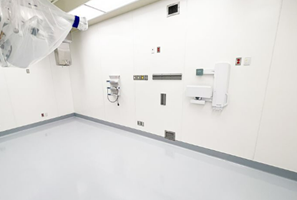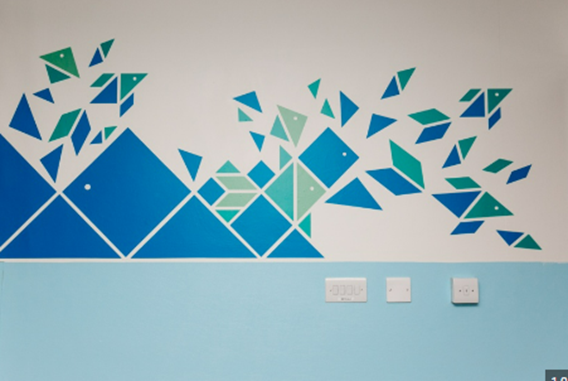11th September 2025

Download a print-friendly version of this article.
FCN has put together a SARC Facility Gap Analysis document to support you with the process of determining whether your facility is compliant.
FCN has been on-site at almost half of the SARCs across England and Wales and remotely reviewed many more SARC floor plans to support the SARCs nationally in improving their facilities to ensure they are of a high standard and in line with the requirements.
Here are some of the common findings and recommendations we have made.
ISO 15189:2022 Section 6.3.3a ‘Storage space, with conditions that ensure the continuing integrity of samples, equipment, reagents, consumables, documents and records, shall be provided’
SARC consumable stores should store forensic consumables only, recommendations are made as per the SARC Consumable Procedure on how these should be stored using the red, amber and green (RAG) system. To ensure the integrity of the forensic consumables, they should not be stored in the same space as cleaning products, equipment and consumables, forensic evidence or post examination consumables such as wash bags, sanitary items, change of clothes or leaflets etc.
Firstly, SARCs should minimise the use of the consumables store, whereby FHPs or Crisis Workers only access this area for the purpose of collecting consumables for an examination or to stock or clean the room. Secondly, the consumable store should be access controlled, whereby only personnel with appropriate consumable receipt, storage, handling and anticontamination training can access.
And most importantly, there is a significant risk of cross contamination between evidence, consumables and cleaning products if these are all stored in the same space.
As mentioned above, the forensic cleaning equipment, consumables and reagents should not be stored in the forensic consumable store. They should also not be stored with the general cleaning equipment, consumables or reagents that are used to clean the non-forensic areas of the facility. Segregation is required to ensure there is no cross contamination or accidental use of the wrong cleaning products in the wrong area.
FSR-G-212 Section 8.3.4.h: There shall be a labelled storage area for keeping consumables used for the forensic medical examination and packaging of samples.
Holding quantities of consumables stocked in the forensic medical examination room which is drawn from for each medical examination poses a significant risk of cross contamination.
This has been discussed with many SARCs and it has been recommended that they consider holding only 'emergency' forensic DNA grade consumables in the medical room, stored in sealed plastic boxes. e.g., one box with one of each size of speculums, one box with a swab kit etc. If an item is used then the contents of that box is disposed of, the box cleaned down and items replaced.
Prior to a forensic medical examination, the FHP collects the consumables they require for that medical from the main SARC consumable store. Anything not used once taken into the forensic medical examination room is disposed of.
FSR-G-212 Section 8.2.11 states: Ceilings should be hard plasterboard or laminated tiles of smooth finish resistant to degradation from frequent cleaning. Fitting should be flush or anti-ligature to allow ease of cleaning. Neither unbagged insulation nor fibrous material should be used above the ceiling.
The ceilings in the forensic medical examination room are often overlooked in a SARC because they do not come into direct contact with forensic evidence, but although the ceilings are low risk in terms of causing potential contamination, there are still some considerations to be made.
It is best to check what is above the ceiling tiles and therefore if maintenance access is required or if the tiles lift when being cleaned then it is important to check there is no insulation or fibrous material that could fall and contaminate the forensic medical examination room. It might be worth considering adding weighted material above the ceiling tiles so that they don’t lift when being cleaned.
All surfaces in the forensic medical examination should be smooth and non-porous, including the ceiling tiles allowing for easy cleaning and reducing the risk of trapped DNA.
FSR-G212 Section 8.2.12 states: Walls should be of smooth finish, sealed and resistant to degradation from frequent cleaning.
FSR Code of Practice Section 102.5.9 states: The walls, floors, work surfaces and chairs should be of smooth finish, sealed, readily cleanable and resistant to degradation from frequent cleaning.
Although again walls in the forensic medical examination room are classed as a lower risk area in the SARC as they are unlikely to come into contact with potential forensic evidence, consideration still needs to be made of their cleanliness.

Whiterock is a material commonly used on walls in DNA clean rooms as it provides a smooth and easily cleanable surface. Alternatively, a durable paint that is resistant to repeat cleaning can be suitable.
Tiles are not recommended, however if your SARC has these in place it might be worth considering their location in the room in relation to risk and conducting environmental monitoring on them to better understand the level of DNA risk they pose before replacing them.
FSR-C-212 Section 8.2.1 states: Accommodation at the facility shall be age appropriate, accessible to the community it serves and with adequate security for the service users and staff. For example, consideration should be given to the style of decor and availability of toys where the facility is being accessed by child patients.
It is a challenge to get a healthy balance between meeting anticontamination requirements whilst ensuring the rooms in the SARC don’t become too clinical or intimidating.
There is no requirement that states SARCs cannot have art and soft furnishings in the forensic areas.
The priority over any forensics is the health and wellbeing of the patient, therefore it is important to consider what images, art or furnishings can be used to soften the look of the forensic areas of the SARC whilst ensuring it remains in line with the requirements, e.g., that it is smooth and easily cleanable.
(Also, consideration of any non-forensic elements such as ensuring images or furnishings are not triggering for the patients).

FSR Code of Practice Section 102.5.4 states: The forensic unit shall have policies and procedures for authorised access to the building, rooms, areas, equipment and consumables. Access shall be recorded for the forensic medical examination room.
It is important to ensure that only authorised personnel have access to the SARC and to the forensic areas of the facility. This can be achieved through use of lock and keys, keypads or swipe card/fob access. It is preferable to have swipe card/fob access whereby the data is recorded on a system of exactly who entered where at what time, providing full traceability. Otherwise, this traceability needs to be achieved by manually recording who has accessed what and when. The FCN have provided a template for recording this access: Access Control Log.
It is important also to ensure that a robust process is in place to ensure door codes are regularly changed and key cards or fobs are collected in and updated when staff leave the organisation.
FSR-G-212 Section 8.2.4 states: ‘There should be an entrance for access to the facility by the patient and their companions that is separate and not open to public traffic’
Therefore, the general public should not be using the same entrance to the SARC building as a patient, the patient entrance should be discreet.
This does not apply to staff; staff can use the same entrance as the patient.
FSR Code of Practice Section 202.5.5 states: The design and layout of the facility should be unidirectional. This shall include measures to prevent cross-transfer and environmental contamination.
To prevent cross contamination the patient should move through the SARC in one direction e.g., from the pre-examination room to the patient toilet to the forensic medical examination room to the post examination room. Many SARCs have in place forensic pods which allows for this one directional movement. Please note though that once the forensic evidence has been recovered there is no longer the risk of cross transfer or environmental contamination, therefore there is no need for the post examination room to be forensic DNA clean.
(Unrelated to forensics, please also consider that a patient reentering a room they have already been in could be triggering and feel like they are starting the process again).
FSR-G-212 Section 8.3.4 d states: Where a curtain shields the examination couch, the curtain shall be disposable. The frequency of curtain replacement will depend on the number of forensic medical examinations conducted in the room and shall be subject to risk assessment. For example, in a facility where more than 20 patients are forensically examined each month, the curtain should be changed monthly. Where fewer medical examinations are conducted the disposable curtain should be replaced at least every three months. However, if any staining is visible on the curtain or material is thought to have been inadvertently transferred to the curtain, it shall be replaced immediately. A record of the date and reason for changing the curtain shall be kept.
This requirement is often not in place at the SARCs. It is also important to consider within the FHP and Crisis Worker training that they are fully aware of this process and that if they do touch the curtain before or during a forensic medical examination that they either replace or clean their gloves as per FSR-G-212 Section 9.2.6: Top gloves shall also be changed after maneuvering the curtain around the couch regardless of whether it is a disposable variety or other type.
Alternatively, SARCs can use a screen which is cleaned after every case.
FSR-G-212 Section 9.4.1 states: ‘In the event that multiple patients from the same incident attend the facility at the same time, staff shall ensure that they do not have contact with more than one patient to prevent cross-contamination. If this is absolutely unavoidable, steps shall be taken to ensure that appropriate precautions are taken to minimise cross-contamination. This shall include staff showering, including washing their hair, and changing their own clothes between each patient’.
The word ‘shall’ has been used therefore it is a requirement that the FHP & Crisis Worker shower between any concurrent cases that may be linked.
There is no requirement or clause stating that staff should or must shower between cases when they are not related. This should be risk-assessed on a case-by-case basis.
Therefore, it is important that a staff shower is considered in the SARC building plans.
Air flow has been raised and discussed at every SARC Facility assessment.
Please refer to issue #02 of the FCN SARC News Article for the latest update on Air Flow requirements.
It is also important to ensure that temperature is considered in the building developments of the SARC, temperature should be regulated ensuring that evidence is not compromised and that the environmental temperature is comfortable for patients & staff.
Further key points within your process to consider:
FSR-G-212 Section 8.2.5 states: ‘The design of the facility shall include measures to prevent cross-transfer and environmental contamination’.
It is important to consider what rooms or areas directly lead from the forensic rooms, most importantly the forensic medical examination room. For example, the entrance to the forensic medical examination room should not lead directly into a staff shower/PPE room or a corridor which is in routine use by other staff as there is a risk that DNA is transferred from these areas into the forensic medical examination room. Where possible the forensic rooms should be laid out in a unidirectional manner or by having each of the forensic rooms leading from a forensic corridor, which is forensically cleaned and is only in use by the FHP, Crisis Worker, patient and essential supporters during the forensic medical examination process.
FSR-G-212 section 8.2.7.d. states: ‘A dedicated area for staff and visitors to change into or put on barrier/ personal protective clothing that is away from the DNA clean examination area’.
SARCs should consider in their building plans where staff are donning PPE, to minimise cross-contamination this should done in a dedicated room that is not used for any other purpose.
The building requirements are essential in ensuring not only that anti-contamination measures are in place and that contamination is minimised, but they also ensure that every patient gets to attend a high quality SARC facility no matter where they are in the country.
If you are unsure on any of the facility requirements, we recommend you conduct a risk assessment using Process Risk Assessment, and/or contact the FCN for support: michelle.gaskell@dorset.pnn.police.uk or guylaine.hanford@dorset.pnn.police.uk.